The AMD A8-7670K APU Review: Aiming for Rocket League
by Ian Cutress on November 18, 2015 8:00 AM ESTOffice Performance
The dynamics of CPU Turbo modes, both Intel and AMD, can cause concern in environments with variably-threaded workloads. There is also an added issue of the motherboard remaining consistent, depending on how the motherboard manufacturer wants to add in their own boosting technologies over the ones that Intel would prefer they used. In order to remain consistent, we implement an OS-level unique high-performance mode on all the CPUs we test, which should override any motherboard manufacturer performance mode.
All of our benchmark results can also be found in our benchmark engine, Bench.
Dolphin Benchmark: link
Many emulators are often bound by single-thread CPU performance, and general reports tended to suggest that Haswell provided a significant boost to emulator performance. This benchmark runs a Wii program that ray traces a complex 3D scene inside the Dolphin Wii emulator. Performance on this benchmark is a good proxy of the speed of Dolphin CPU emulation, which is an intensive single-core task using most aspects of a CPU. Results are given in minutes, where the Wii itself scores 17.53 minutes.

All AMD CPUs performed similarly here.
WinRAR 5.0.1: link
Our WinRAR test from 2013 is updated to the latest version of WinRAR at the start of 2014. We compress a set of 2,867 files across 320 folders totaling 1.52GB – 95% of these files are small typical website files, and the rest (90% of the size) are small 30-second 720p videos.
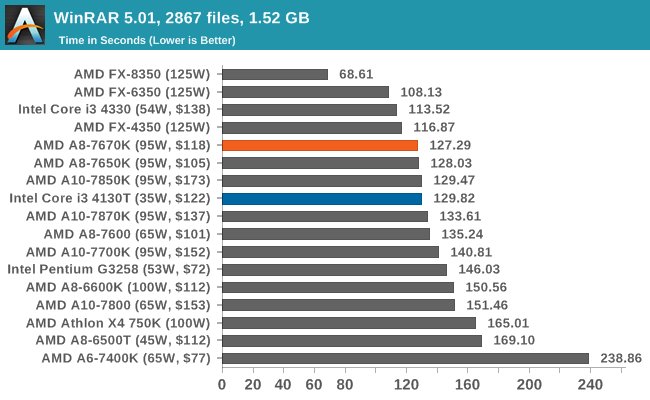
WinRAR is all about threads and DRAM speed, so the CPUs that can support higher DRAM frequencies get a boost.
3D Particle Movement
3DPM is a self-penned benchmark, taking basic 3D movement algorithms used in Brownian motion simulations and testing them for speed. High floating point performance, MHz and IPC win in the single-thread version, whereas the multithread version has to handle the threads, and loves more cores.
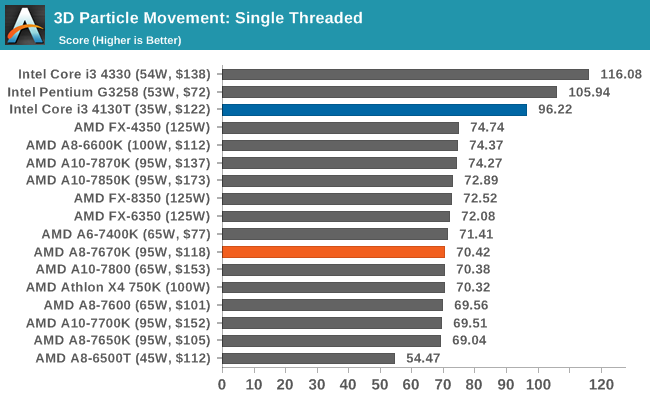
Again, all AMD CPUs seem to perform similarly in 3DPM for single-thread mode, indicating that something more fundamental about the design is a bottleneck.
FastStone Image Viewer 4.9
FastStone is the program I use to perform quick or bulk actions on images, such as resizing, adjusting for color and cropping. In our test, we take a series of 170 images in various sizes and formats, and convert them all into 640x480 .gif files, maintaining the aspect ratio. FastStone does not use multithreading for this test, and results are given in seconds.
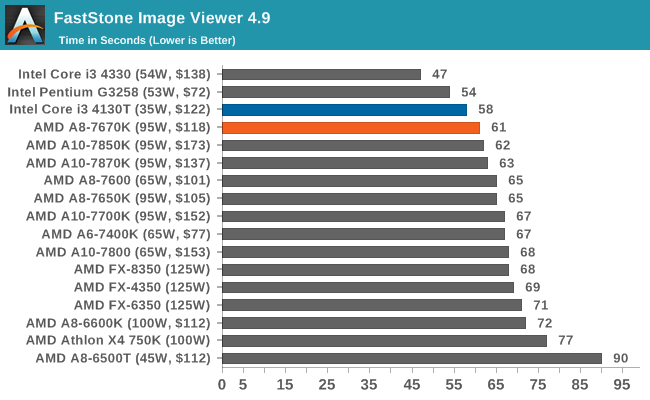
Single-thread frequency and IPC win here.
Web Benchmarks
On the lower-end processors, general usability is a big factor of experience, especially as we move into the HTML5 era of Web browsing. For our Web benchmarks, we take four well-known tests with Chrome 35 as a consistent browser.
Mozilla Kraken 1.1
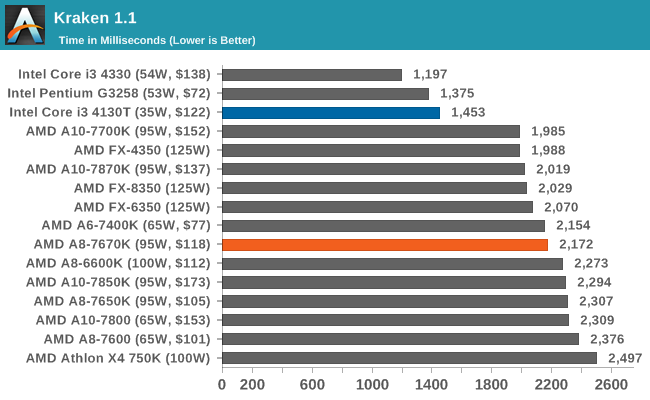
WebXPRT
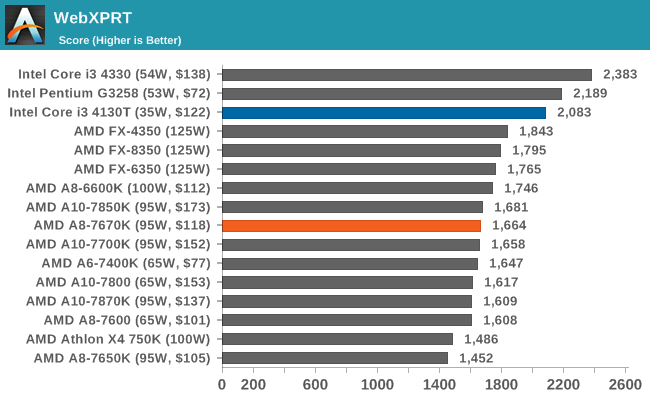
Google Octane v2
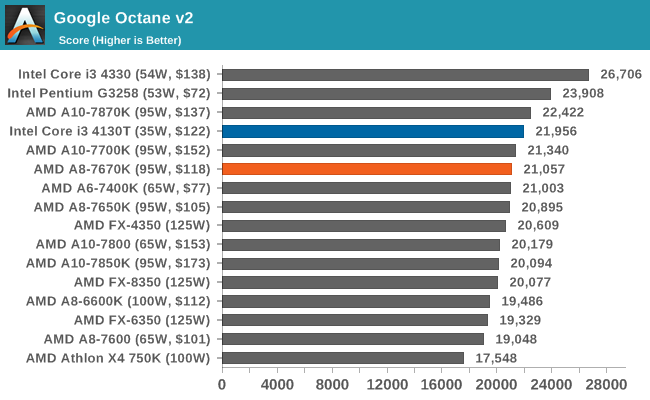










154 Comments
View All Comments
milli - Thursday, November 19, 2015 - link
Sounds good :)BrokenCrayons - Thursday, November 19, 2015 - link
95 watts is too much for a modern CPU to require.plonk420 - Thursday, November 19, 2015 - link
that's watts TDP, not watts at the wall.BrokenCrayons - Friday, November 20, 2015 - link
Yes, that's fine. It's too high for a modern CPU. Half that would be more reasonable and a tenth would be better still, but not at all perfect.TheinsanegamerN - Friday, November 20, 2015 - link
The i3 is still a 47 watt chip. the skylake i7s are 95 watt. It seems most "modern" cpus are in the 65-95 watt range, with 47 watt for dual cores.A tenth of 95 watt is only 9.5, which is core m territory. it works, but it ISNT for power users. So i'm not sure what 'modern' cpu you are referring to, as it doesn't seem to exist. And AMD's APUs can be set to 65 or 45 watt mode as well, but you get a performance hit. So half the TDP already exists, and a tenth is too little for a big CPU.
BrokenCrayons - Friday, November 20, 2015 - link
Yes, the i3 is an Intel processor. Skylake's 95 watt chip is an outlier that's highly uncommon. The vast majority of computers purchased are inexpensive laptops which regularly only rise to 35 watts. Desktop processors are not only a rarity, but those that range above 65 watts are very uncommon and largely the domain of expensive workstations and the very small number of gaming systems out there. It's pretty odd of AMD to sell a budget processor that puts those kinds of demands on a system and, in my opinion, unreasonable given the competition in the same approximate performance.silverblue - Friday, November 20, 2015 - link
I know it's hardly comparable, but I wonder what power an i3 with Godavari-level GPU would use if at 28nm. Besides, TDP != actual power usage.TheinsanegamerN - Friday, November 20, 2015 - link
Desktops are rare now? Ok. You must not work in business. Desktops Are still common, not as much as laptops, but the forecast for all of 2015 was north of 120 million desktops, the vast majority of which are business machines with i5 processors, which are 65-84 watt. I7s are rated at 84 watt for haswell, 77 for ivy bridge, and 95 for sandy bridge, and 95 for skylake, so it's much more common than you think.As for laptops, I'm not sure why you brought them up, seeing as the a8 is a DESKTOP chip. on DESKTOPs, CPUs with 65 watt TDPs are very common. Any i5, i7, pretty much any APU from AMD, are all 65 watt+. Laptops typically use dual core chips with much lower clock rates and power restricted GPUs. The vast majority of laptops, with those 35 watt chips (and most of the skylake and broadwell chips in laptops are 15 watt BTW, 35 watt isn't really used much anymore) can't compare to a 95 watt desktop chip in performance, so it still won't work for power users.
So when you say that the TDP is too high for a modern processor, you mean it's too much for a mobile processor, ignoring that this is a processor for desktops. Unless you want a desktop processor with a mobile TDP but desktop performance, which will never happen, because a higher TDP chip will be clocked higher. Always.
Deshi - Friday, November 20, 2015 - link
Does that 95 watts include the onboard GPU? if thats the case, thats not so bad, since you would need to addin the added dGPU TDP if you build an intel + nvidia/radeon to match the performance.nos024 - Thursday, November 19, 2015 - link
blah...after 4 years and Intel's IGP is still on the heels of AMD's APU. Bleh.Give me graphics performance comparable to a 750ti and an ITX motherboard with M.2 storage option and I'll will go and buy it this very instance. I want something like that.
Low profile ITX-case + 8gb RA
M + 240/256GB M.2 RAM (SATA or PCIe) + 300W PSU + ITX MB with AC wireless + APU with 750ti GPU performance. Is that so hard to ask for?! Apparantly so.